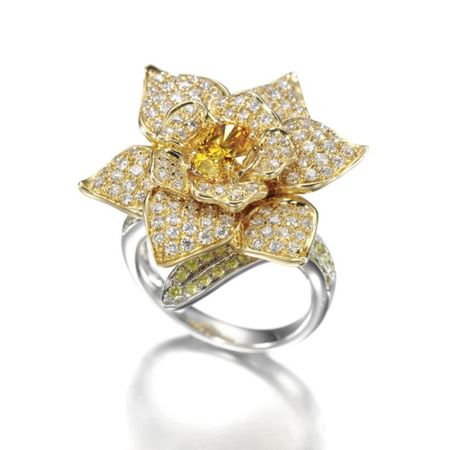Fancy Vivid Orange-Yellow Diamond, Diamond And Peridot Ring, George Pragnell, Circa 2008
Fancy Vivid Orange-Yellow Diamond, Diamond And Peridot Ring, George Pragnell, Circa 2008
Designed as a daffodil, centring on an oval fancy vivid orange-yellow diamond weighing 0.82 carats, the petals pavé-set with brilliant-cut near colourless diamonds, the leaf and shoulders set with circular-cut peridots, size N ½, signed Pragnell and numbered, cased, accompanied by a facsimile design of the ring by George Pragnell. Estimate 20,000—40,000 GBP
NOTE: Accompanied by a report from The Precious Stone Laboratory, no. 984218, stating that the Fancy Vivid Orange-Yellow diamond weighing 0.82 carats, is natural.
This is a unique jewel created by George Pragnell for the 60th Anniversary of Marie Curie Cancer Care. The money raised through the sale of this beautiful Daffodil Diamond Ring by George Pragnell will help fund Marie Curie Nurses, who care for people with terminal illnesses, giving them the choice to die at home supported by their families.
George Pragnell is known as both a manufacturer and jewellery retailer, the company started in 1954. Charlie Pragnell, the founder's Grandson, based the design of the ring around the charity's emblem, the daffodil.
The ring was made in George Pragnell's workshops, Stratford upon Avon, home of Shakespeare. It is crafted in 18 carat yellow and white gold, centring on a rare oval Fancy Vivid Orange Yellow diamond weighing 0.82 carats, its petals pavé-set with near-colourless diamonds, with subtle green peridots to the stem and leaf.
This piece is a credit to British craftsmanship, it demonstrates that the skill of the goldsmith is still very much alive and required in making a bespoke jewel that is both original and unrivalled.
Historic coloured diamonds such as The Tiffany Diamond, a magnificent Fancy Yellow 128.54 carat diamond and the Hope Diamond, a Fancy Dark Greyish-Blue 45.52 carat diamond, have captured the public's attention over the years and the demand for coloured diamonds has continued to increase and is reflected in the high prices achieved for these rare stones at auction.
The first major discovery of quantities of what today would be considered fancy-yellow diamonds occurred at several locations in South Africa in the late 1860's starting with the Eureka discovered in 1866 on farmland. Today, yellow diamonds are found in the productions of mining operations throughout the world but only 1% of those diamonds mined are naturally coloured.
Fancy coloured diamonds are graded based on two factors. The first is their basic hue, such as pink, yellow, blue and even green, it is interesting to note that a secondary undertone that enhances the colour of a diamond is considered a plus, while a secondary undertone that detracts from the colour is thought to be a negative. The second is their intensity of colour. Both colour characteristics form the basis for determining a fancy coloured diamond's rarity and value.
When grading fancy coloured yellow diamonds, the Gemological Institute of America, G.I.A uses the following categories:
1. Fancy Light
2. Fancy
3. Fancy Intense
4. Fancy Dark
5. Fancy Deep
6. Fancy Vivid
Unlike other coloured diamonds (except brown) yellow diamonds with grades of Faint, Very Light and Light are not considered to be fancy-coloured diamonds, but are part of GIA's D-Z colour grading scale.
The formation of white diamonds involves a process that requires the presence of carbon being crystallised under immense heat and pressure deep in the earth's crust, but to colour a diamond one also needs the presence of additional trace elements and distortions to the typical diamond crystal. If an element interacts with carbon atoms during a diamond's creation, the diamond's colour can change. Radiation and pressure on a diamond's structure will also impact its colour as well. The presence of nitrogen can impart yellow or orange shades to a diamond.
Marie Curie Cancer Care has provided end of life care for 60 years and appropriately the charity was founded in 1948 following the donation of a diamond engagement ring, this raised £75 at auction, equivalent today to approximately £5,762.
Sotheby's. Fine Jewels.| 06 Nov 08 10:30 AM. London - www.sothebys.com - Photo Courtesy Sotheby's

/https%3A%2F%2Fprofilepics.canalblog.com%2Fprofilepics%2F1%2F0%2F100183.jpg)
/https%3A%2F%2Fstorage.canalblog.com%2F03%2F02%2F119589%2F96711876_o.jpg)
/https%3A%2F%2Fstorage.canalblog.com%2F11%2F31%2F119589%2F94773502_o.jpg)
/https%3A%2F%2Fstorage.canalblog.com%2F20%2F83%2F119589%2F94772815_o.jpg)
/https%3A%2F%2Fstorage.canalblog.com%2F26%2F72%2F119589%2F75604929_o.jpg)
/https%3A%2F%2Fstorage.canalblog.com%2F59%2F60%2F119589%2F26458628_o.jpg)



/http%3A%2F%2Fstorage.canalblog.com%2F63%2F55%2F119589%2F128916709_o.jpg)
/http%3A%2F%2Fstorage.canalblog.com%2F12%2F74%2F119589%2F120223779_o.png)
/http%3A%2F%2Fstorage.canalblog.com%2F28%2F56%2F119589%2F116033843_o.jpg)
/http%3A%2F%2Fstorage.canalblog.com%2F31%2F81%2F119589%2F107388992_o.jpg)